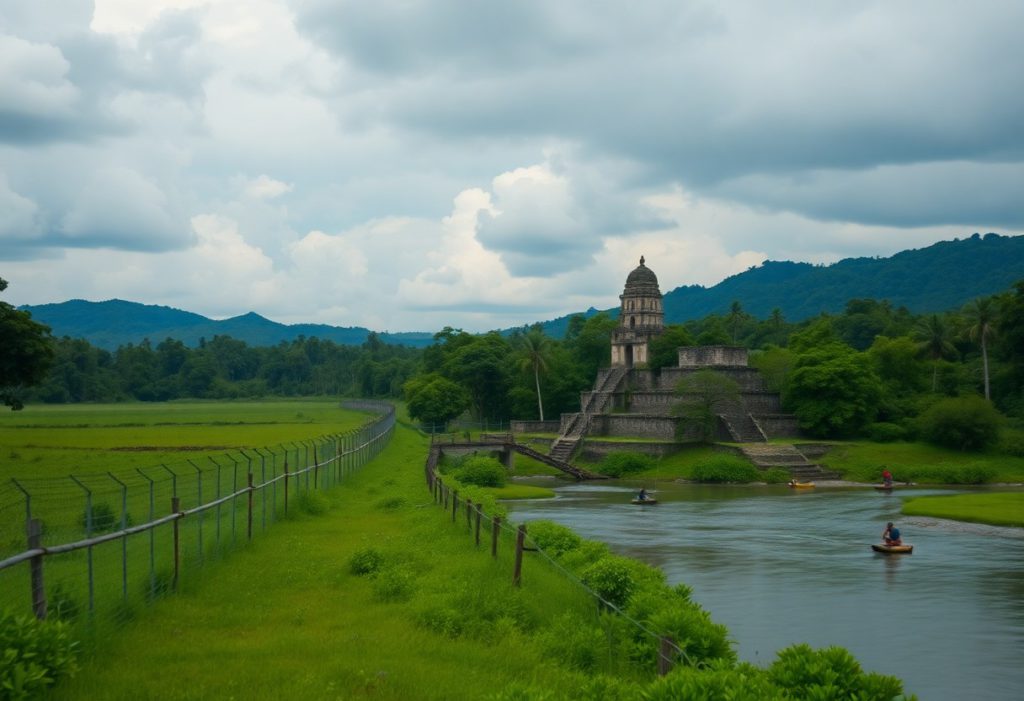The intricate and multifaceted territorial dispute between Belize and Guatemala represents a long-standing geopolitical tension that has endured for centuries, surprising many due to its complexity and the depth of its historical roots. This ongoing border conflict, deeply entrenched in colonial-era claims, has consistently posed a significant threat to regional stability. Since gaining independence, Guatemala has persistently challenged Belize's sovereignty, creating a backdrop of diplomatic friction and tension. However, recent developments have sparked a sense of hope for peaceful resolution. In a landmark 2019 referendum, citizens of both nations voted to seek resolution through the International Court of Justice. This initiative is a promising signal of a potential breakthrough in their contentious relationship. To truly comprehend the complexities of this border dispute, it is crucial to delve into its intricate historical narrative, which is vital for understanding the broader geopolitical dynamics of Central America.

Diving Deep into the Colonial Roots of the Belize-Guatemala Dispute
The complexity of the territorial disagreement between Belize and Guatemala can be traced back to colonial-era territorial claims, fueled by the imperial ambitions of Spain and the expansion of British colonial interests. This dispute originated from the competing interests of European powers in Central America, with both nations asserting claims over strategically significant areas. The unresolved boundary issues have evolved into a persistent source of tension, reflecting the complicated historical dynamics surrounding territorial sovereignty in the region. The legacies of these colonial claims continue to shape the political landscape, illustrating how historical grievances can influence contemporary diplomatic relations and ongoing conflicts.
Analyzing the Impact of the 1859 Boundary Treaty on Territorial Claims
Set against the backdrop of imperial negotiations, the 1859 Boundary Treaty between Britain and Guatemala sought to establish clear territorial borders. However, rather than resolving conflicts, this agreement inadvertently created more complications than it alleviated. The treaty’s ambiguous language and its varied interpretations have become a fundamental source of ongoing territorial disputes between the two nations. The complexities surrounding the treaty highlight the enduring impact of colonial agreements on contemporary conflicts, as both Belize and Guatemala grapple with the ramifications of historical treaties that continue to influence their diplomatic relations and territorial understandings.
Exploring the Historical Context of Territorial Negotiations
From the era of Spanish colonial dominance to the establishment of modern nation-states, a complex landscape of territorial negotiations has emerged. The geopolitical dynamics of the region were significantly influenced by imperial rivalries and the fluid boundaries of colonial territories, laying the groundwork for future conflicts between nations. These boundary disputes reflect a deeper narrative involving colonial legacies and postcolonial territorial challenges that persist today. The strategic importance of the territory has historically fueled conflicts, with Guatemala consistently contesting Belize’s sovereignty. The multifaceted nature of this dispute encompasses issues of historical interpretation, indigenous rights, and territorial integrity, rendering it a complex international controversy that continues to have profound implications for diplomatic relations between the two nations.
Identifying Key Issues in the Belize-Guatemala Border Dispute
The intricate border dispute between Belize and Guatemala encompasses a variety of historical, territorial, and political dimensions that are crucial to understanding the ongoing friction. Key tensions arise from competing claims over land, assertions of sovereignty, and differing interpretations of historical narratives. The conflict, deeply rooted in colonial boundaries, has been perpetuated by international legal disputes and enduring nationalist sentiments, presenting significant obstacles in the diplomatic landscape for both nations. Grasping these core issues is essential for addressing the complexities of the dispute and working towards a comprehensive resolution that respects the interests of both countries involved.
Guatemala’s Assertion of Territorial Claims
Primarily, Guatemala claims approximately 12,000 square kilometers of Belizean territory, asserting historical rights that arise from Spanish colonial boundaries. Their claim challenges the legitimacy of British territorial acquisitions, focusing on interpretations of historical treaties and colonial agreements that Guatemala argues were implemented unjustly. This assertion reflects Guatemala's ongoing struggle to reclaim what it considers ancestral land, underscoring the deep-seated grievances that fuel the dispute and highlighting the necessity for a nuanced and informed approach to resolution that acknowledges the historical context and contemporary realities.
Belize's Defense of Sovereignty and Territorial Integrity
The arguments surrounding Belizean sovereignty underscore the nation's unwavering right to self-determination and the protection of its territorial integrity. Belize firmly maintains its independence and categorically rejects Guatemala’s territorial assertions, emphasizing the importance of international recognition and the legal principle of uti possidetis juris, which supports the maintenance of existing colonial boundaries following independence. A deeper exploration reveals that Belize’s sovereignty is firmly backed by international law and numerous resolutions from the United Nations. The country has consistently advocated for its territorial integrity through diplomatic channels, garnering international support to fortify its borders against claims. Furthermore, peaceful resolution mechanisms, including international mediation, have become vital strategies in addressing the long-standing dispute, fostering hope for a viable solution.

Exploring Diplomatic Endeavors for Conflict Resolution
The efforts to resolve the enduring border conflict between Belize and Guatemala have involved various international mechanisms and negotiations aimed at achieving a sustainable peace. Both nations recognize the potential risks associated with continued territorial tensions, leading them to seek peaceful solutions through diplomatic channels. International mediation and bilateral discussions have been instrumental in gradually reducing historical animosities and fostering pathways toward resolution. Understanding these diplomatic efforts can illuminate the progress made and the challenges that remain in achieving a lasting peace that benefits both nations and their citizens.
Insights into the Diplomatic Negotiation Process
The diplomatic negotiations between Belize and Guatemala have been characterized by gradual progress and strategic dialogue aimed at fostering mutual understanding and cooperation. These talks have focused on exploring potential compromise solutions that could satisfy the interests of both nations. Key diplomatic initiatives have involved high-level meetings, bilateral commissions, and international facilitation, all designed to address territorial claims and promote regional stability. This ongoing dialogue highlights the significance of diplomacy in resolving complex geopolitical issues and the importance of maintaining open channels of communication in pursuit of peace.
The Role and Significance of the International Court of Justice in Mediation
The International Court of Justice (ICJ) plays a critical role in mediating the border dispute between Belize and Guatemala. The ICJ provides a neutral legal platform for addressing territorial claims, offering an internationally recognized mechanism for dispute resolution that has the potential to conclude decades of territorial tensions. The court's involvement is not merely a matter of arbitration; it represents a critical turning point in the relationship between Belize and Guatemala. By agreeing to submit their dispute to the ICJ, both countries have demonstrated a commitment to pursuing peaceful resolution through legal means. The court's forthcoming ruling could definitively address territorial boundaries, potentially establishing a permanent legal framework for future bilateral relations and fostering regional stability through cooperation and understanding.

Understanding the Impact of the Dispute on Travel and Trade Dynamics
Navigating the complex Belize-Guatemala border necessitates a thorough understanding of its multifaceted challenges. The historical territorial disputes have had significant repercussions on cross-border interactions, shaping unique travel and economic dynamics that influence the lives of people in both countries. Ongoing tensions have affected transportation routes, trade patterns, and the diplomatic relations between these neighboring nations. The border region requires careful consideration of geopolitical sensitivities that could impact movement and economic exchanges, making it essential for travelers and businesses to stay informed and prepared for potential changes in the situation.
Current Travel Guidelines for Safety and Awareness
Traveling along the Belize-Guatemala border necessitates exercising heightened caution due to the sensitive nature of the geopolitical landscape. Your safety hinges on staying informed about current diplomatic conditions and potential conflict zones. Official travel advisories recommend regularly checking government websites prior to crossing, verifying documentation, and maintaining awareness of local security situations. Planning your route carefully, including the use of official border crossing points, can minimize risks and enhance your travel experience in this sensitive region, ensuring a safe and enjoyable visit.
Analyzing the Dynamics of Cross-Border Trade
The trade relations between Belize and Guatemala at the border remain intricate and continually evolving, reflecting the complexities of their historical relationship. Despite the enduring tensions, agricultural products and small-scale commercial exchanges persist, demonstrating the economic interdependence that continues to exist between these two nations. To fully understand these interactions, one must recognize the resilience of economic relationships that thrive despite political challenges. The trade landscape reveals a complex web of interactions where agricultural commodities such as sugar, citrus, and timber play significant roles in cross-border exchanges. Informal trade networks, facilitated by local merchants, navigate the diplomatic complexities, highlighting how economic cooperation can endure amidst territorial disputes. Ongoing bilateral agreements and diplomatic negotiations continue to shape these economic interactions, offering promising prospects for future collaboration and mutual benefits for both countries.
Examining the Socio-Political Implications of the Dispute
The border dispute between Belize and Guatemala extends well beyond mere geographical lines, embodying profound socio-political implications for both nations. This territorial conflict significantly impacts diplomatic relations, national security strategies, and broader regional dynamics. The ongoing tensions create complex socio-political challenges that influence governmental strategies, international negotiations, and the daily lives of citizens in both countries. Understanding these implications is vital for comprehending the broader effects of the dispute on the region, as it shapes policies and perceptions in both Belize and Guatemala.
National Identity and Public Sentiment Surrounding the Territorial Dispute
The border dispute deeply resonates with national pride and historical narratives in both Belize and Guatemala. Each country perceives the territorial claims as a matter of fundamental sovereignty, leading to passionate public discourse and political sentiment. This conflict has evolved into a symbol of national identity, as citizens fervently defend their historical perspectives and territorial integrity. The emotional weight of these claims significantly shapes public opinion, influencing political discourse and national policy. The intricate relationship between territorial disputes and national identity highlights the importance of understanding how historical grievances can affect contemporary societal dynamics and international relations.
Assessing Regional Stability and Security Challenges
The ongoing border dispute poses potential vulnerabilities in regional peace and cooperation. Unresolved territorial claims generate diplomatic tensions that could destabilize bilateral relationships and affect broader regional security dynamics. Recognizing these challenges is crucial for understanding the complex geopolitical landscape of Central America. The dispute represents more than a mere territorial disagreement; it threatens regional stability through the risk of military escalations and conflict. The persistent tension complicates economic cooperation, cross-border trade, and collaborative security efforts among neighboring countries. Awareness of these dynamics elucidates how unresolved territorial claims can undermine diplomatic progress and create long-term challenges for peaceful coexistence between Belize and Guatemala.
Envisioning Future Prospects for Diplomatic Resolution
Despite the complex historical tensions, the situation along the Belize-Guatemala border presents potential pathways for diplomatic resolution. Ongoing negotiations and international mediation hold the promise of achieving a peaceful settlement that respects the interests of both nations. The international community continues to support constructive dialogue between both nations, suggesting that a comprehensive resolution may be attainable in the coming years. The commitment to diplomacy signifies a crucial step toward addressing longstanding grievances and fostering a more stable future for both countries and their citizens.
Identifying Potential Resolutions to the Ongoing Dispute
Resolutions to the enduring territorial dispute could involve international arbitration or a mutually agreed-upon territorial compromise that respects the claims of both parties. Observing the recent willingness of both countries to engage in diplomatic discussions suggests that a mutually beneficial agreement may be on the horizon. The involvement of neutral international bodies could provide a structured framework for resolving historical claims, paving the way for more effective conflict resolution strategies that prioritize peace and stability in the region.
The Role of International Relations in Shaping Border Negotiations
International relations significantly influence the border negotiations between Belize and Guatemala. Diplomatic channels have emerged as vital tools for managing territorial tensions and fostering dialogue between the two nations. Regional organizations and global diplomatic platforms continue to play essential roles in facilitating discussions and seeking peaceful solutions to the border conflict. Additionally, the broader geopolitical context affects these border relations, as international pressure and diplomatic engagement create opportunities for resolution. The potential for economic cooperation, joint development projects, and shared security interests presents promising avenues for collaboration. Organizations like the OAS have been instrumental in mediating discussions and promoting peaceful interactions between Belize and Guatemala, emphasizing the importance of diplomacy in resolving international disputes.
Frequently Asked Questions About the Belize-Guatemala Territorial Dispute
What is the historical background of the territorial dispute between Belize and Guatemala?
The territorial dispute arose from Spanish colonial claims and British settlement in the region during the 19th century. Initially, Spain claimed the territory, but Britain established settlements in Belize, resulting in complex legal and territorial challenges. The conflict centers on competing territorial assertions, with Guatemala maintaining claims to most of Belize’s land following Central American independence in 1821, highlighting the enduring legacy of colonialism in shaping contemporary territorial disputes.
How did the international community help resolve the long-standing border conflict?
The Organization of American States (OAS) played a significant role in mediating the conflict. In 2008, both countries agreed to submit their dispute to the International Court of Justice (ICJ) for a binding resolution. A referendum in both Belize and Guatemala during 2018-2019 demonstrated public support for international judicial intervention, ultimately paving the way for a peaceful resolution mechanism that reflects the aspirations of both nations for stability and cooperation.
What is the current status of the Belize-Guatemala border agreement?
In May 2019, the ICJ definitively ruled on the territorial dispute, largely affirming Belize’s sovereignty while making minor adjustments to the border demarcation. The ruling granted Belize approximately 12,272 square kilometers of territory, providing a clear legal framework for future diplomatic relations and establishing permanent maritime and land boundaries between the two nations. This decision marks a significant step toward resolving historical grievances and fostering more stable bilateral relations in the years to come.
The Article The Belize-Guatemala Border: History, Conflict, and Current Status appeared first on Belize Travel Guide
The Article Belize-Guatemala Border: Historical Conflicts and Current Status Was Found On https://limitsofstrategy.com



Your exploration of the Belize-Guatemala territorial dispute genuinely highlights the intricate layers of history that can complicate modern geopolitical relations. It’s fascinating how colonial legacies continue to influence present-day issues, shaping national identities and diplomatic interactions. The 2019 referendum you mentioned is indeed a crucial turning point; it reflects not just a collective desire for peace but also a shift towards seeking resolution through international legal means.
You’ve touched on a significant aspect of the Belize-Guatemala territorial dispute, and it’s true that the shadows of colonialism loom large over many modern geopolitical issues. When we look at how these disputes have evolved, it’s striking to see how historical events continue to shape national identities and diplomatic stances. The legacies of colonialism create perceptions that don’t easily fade and influence the narratives nations tell about themselves and their neighbors.
You raise an important point about the enduring impact of colonial legacies on contemporary territorial disputes like the one between Belize and Guatemala. It’s fascinating how historical narratives are so vital to national identity; they shape not just policies but also the collective psyche of a nation. When we consider how these disputes persist, it’s a reminder that the scars of history are not brushed aside easily.